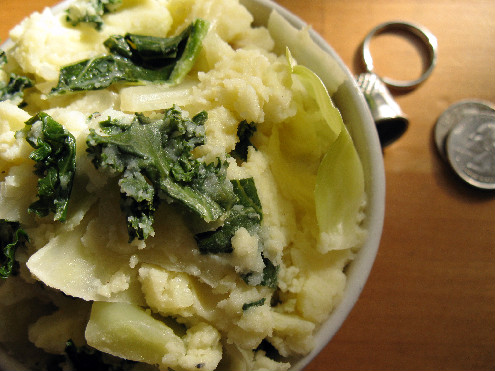Kale: Irish Colcannon Mashed Potatoes & Halloween
Tuesday, October 25th, 2011One of the best things about having this blog is discovering how other cultures use ingredients. I was thrilled to learn about another use for kale in Irish colcannon – mashed potatoes. Coincidentally, colcannon is a favorite this time of year for Halloween.
Colcannon (“cal ceann fhionn” or “cal ceannann”) is an Irish version of mashed potatoes with extra goodies like kale and cabbage added. It is one of Ireland’s national dishes. Early recipes of colcannon date back to the early 1700s. Later the dish was introduced to the English who then modified it to create their version called “bubble and squeek.”
Colcannon potatoes are typically served year-round by home-cooks and restaurants, but colcannon’s more interesting tale is its association with Hallow’s Eve.
In some parts of Ireland, various objects with symbolic meaning were folded into the mashed potatoes. Finding a ring in your spuds meant you were sure to marry in the next year, a coin a sign of wealth, a thimble meant you’d be a spinster, and a button a bachelor.
In other parts, young unmarried ladies were also purported to fill their socks with spoonfuls of colcannon and tie them to their front doors. Apparently, the first available man to walk through the door would be a suitor.
I don’t know about colcannon’s powers for divination, but these mashed potatoes are a welcome alternative to regular ones.
Although colcannon was originally considered peasant food, these creamy mashed potatoes made with lots of butter and sautéed kale, cabbage, garlic and nutmeg are not skimp on flavor. I’d much rather fill up my belly than some socks with this version. But, then again, I already have my husband.
Tidbits on Kale:
- Kale has been cultivated for more than 2000 years.
- Northern Europeans were fond of kale because of its high vitamin content – it has ample amounts of vitamins A and C, folic acid, calcium and iron.
- Choose kale that is rich in color; leave should not be limp or yellowing. Store it the coldest section of the refrigerator. Eat within 3 days or before the leaves start to turn limp.






